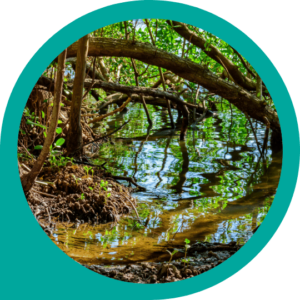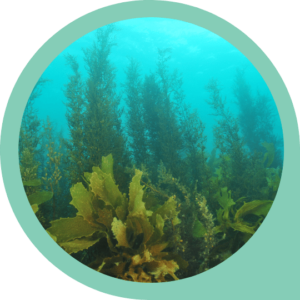We partnered with NOWU to bring to you this great quiz on all things ecosystems! A big thank you to Dr. Columba Martínez-Espinosa for sharing her expertise.
You can read it in French and use the interactive quiz here.
Before we get started, a little reminder: an ecosystem is a given physical environment with a certain number of specific characteristics such as humidity, a specific climate, etc., in which different organisms interact and depend on each other to live. If one of the elements is removed from an ecosystem, it works less well.
Today we want to uncover some special ecosystems…
Mangrove Biome (Mangal)
To put it very simply, it is a forest that grows in the sea! It is filled with mangroves: trees that can grow in mud and salt water.
What is the secret of certain species to “breathe” in water?
- Mushrooms
- Gillyweed
- Vertical Roots
The correct answer is ...
… 3. Vertical Roots
Some mangrove trees grow pneumatophores, vertical roots that come out of the mud (and water) to breathe through tiny openings. Mangroves are very cool: they are home to many species of birds, crabs, molluscs, fish and they limit the damage from storms or tsunamis. They also store carbon like no other, a real asset in the fight against climate change.
Kelp Forests
This is another type of underwater forest! They are made up of brown seaweed that grows from the bottom to the surface, and can be several tens of meters long!
What tool do they use to help carbon sequestration and limit climate change?
- The gas bubbles they use to float
- Their very long roots
- The fact that they are carnivorous as eat fish that emit CO2
The correct answer is ...
… 1. The gas bubbles they use to float
Kelp has gas pockets: when it detaches from the bottom it allows it to float offshore, where it sinks once its pockets are pierced → it then carries the accumulated carbon to the depths of the sea, where it will stay a long time. It’s also a great ally of biodiversity: more than 350 different species can live on a single kelp foot!
Seagrass beds
Now, we are talking about underwater forests rather than underwater meadows (well, it’s still something happens underwater)! Seagrasses are large expanses of plants that grow not too deep, where the water is clear enough to allow them to have light.
The dugong, a marine mammal that feeds on seagrass, can graze up to:
- 3kgs per day
- 1k5g per day
- 40kg per day
The correct answer is ...
… 3. 40kg per day
Seagrasses are a great source of food for marine fauna, but also shelter for many species such as seahorses for example. In addition to being very biodiverse ecosystems, they oxygenate the water, slow down currents and therefore erosion on the coasts, and they store a lot of carbon too! It is therefore very important to protect them against pollution (in particular agricultural fertilizers etc.) but also from human activities such as navigation → Boats which drop their anchor in the middle of these magnificent but fragile seagrass meadows are very dangerous!
Bogs
Aka wetlands in which plant debris accumulates: the water that “soaks” these environments prevents this debris from completely decomposing, and this forms “peat”.
Bogs contain on average:
- 2% carbon
- 20% carbon
- 50% carbon
The correct answer is ...
… 2. 20% carbon
It’s one of their superpowers, peatlands store more carbon than is present in the atmosphere! Problem: if these natural environments are disturbed, for example by draining the water (= by removing the water) to be able to cultivate it, they release it. And that has many other consequences: on all the animals and vegetation that these unique ecosystems shelter, on the water cycle that peatlands help to regulate thanks to their absorbing “sponge” role, on the risk of fires spreading if they dry up, etc.
Swamps
The marshes are buffer zones between a humid zone like the ocean for example and the land. They too have a fairly rich biodiversity.
The name of the part of the marsh flooded by water at high tide is:
- Salt marsh
- Bay mud
The correct answer is ...
… 1. Salt marsh
This part of swamps/marshland is both very rich in biodiversity (it is home to fish, birds, invertebrates, etc.) and vital for many coastal communities which are partly protected from storms thanks to its buffer effect.
Bonus: like the peat bogs, the fact that these are poorly oxygenated environments means that organic matter does not decompose as quickly as elsewhere, and it can therefore store carbon for a very, very long time if left untouched!
We hope this allowed you to learn something new!
Sources
Dr. Columba Martínez-Espinosa, Wetlands Specialist
CNRS, Biodiversity and climate same fight
CIRAD, Biodiversity – A tool to assess the rehabilitation of mangroves
The Conversation, “Arctic Undersea Forests Growing as Fast as Warming”
Harvard, “How Kelp Naturally Combats Climate Change”
Pôle Relais Tourbière, “Why must we protect peatlands? »
RTS, “Better management of peatlands could reduce CO2 emissions”
French Office for Biodiversity, “Seagrass meadows: underwater meadows with a considerable ecological role”
PEW, “Healthy Salt Marshes Harbor Rich Biodiversity—and Help Fight Climate Change”








 YEE aims to unite environmental youth non-profit organisations in Europe in order to enhance international cooperation, increase knowledge about the climate crisis, raise awareness of environmental problems and to strengthen participation of youth in environmental decision-making.
YEE aims to unite environmental youth non-profit organisations in Europe in order to enhance international cooperation, increase knowledge about the climate crisis, raise awareness of environmental problems and to strengthen participation of youth in environmental decision-making.

